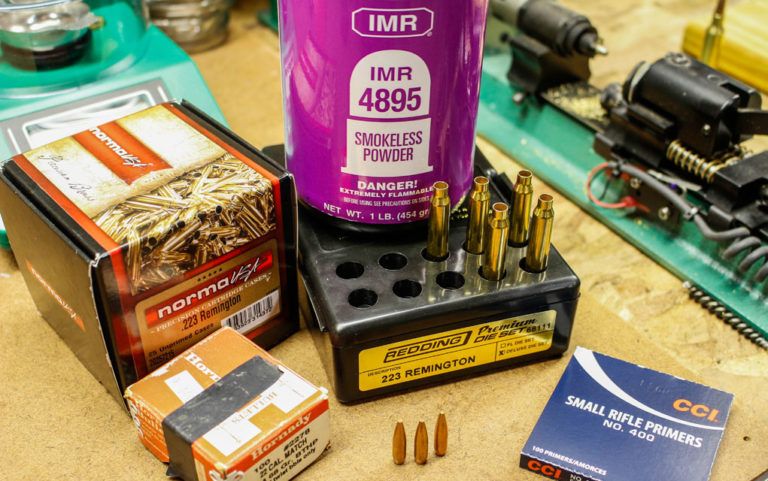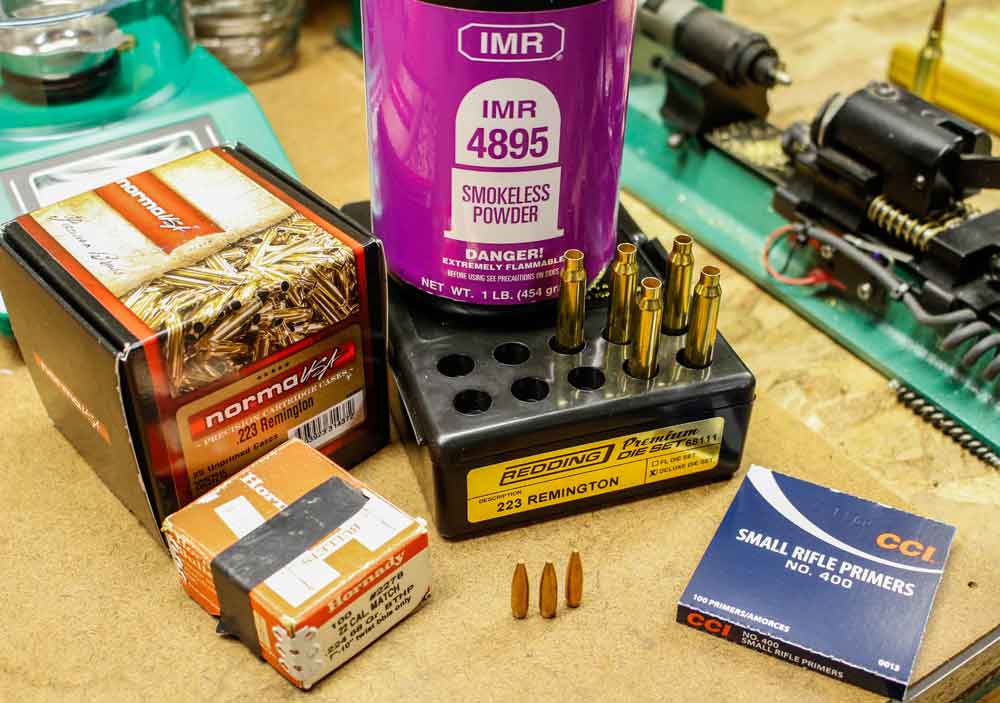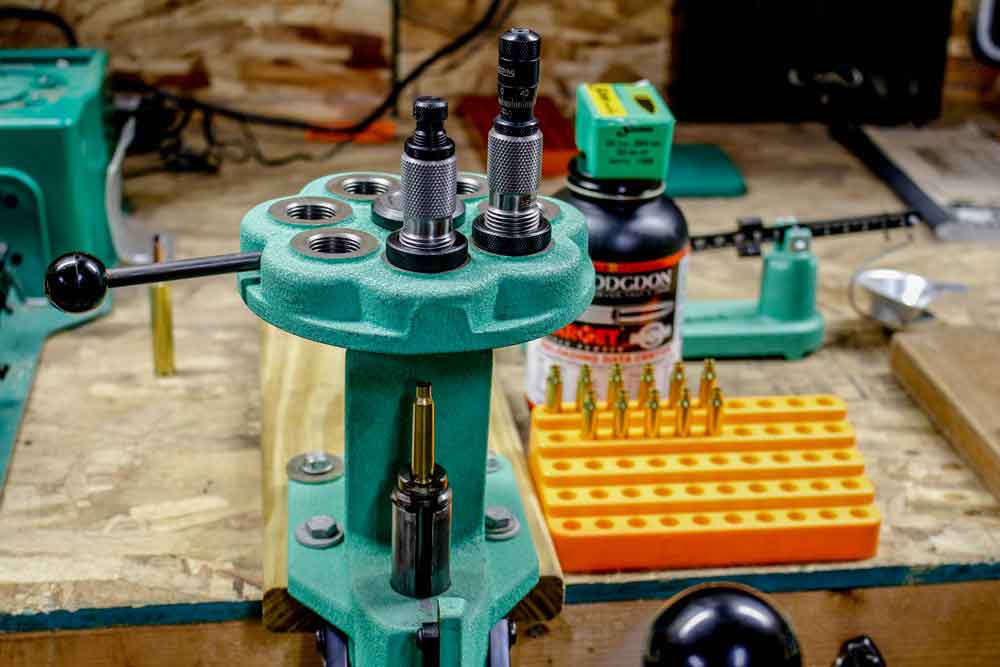
The .223 Remington is a highly versatile cartridge that can be loaded to meet the shooter’s exact needs, but there are certain considerations to keep in mind.
What are some important things to know when reloading the .223 Remington?
- If you're shooting an AR or a semi-auto rifle, consider using small base resizing dies to shrink fired brass back to specs and reduce the chances of a jam.
- If you're shooting a bolt gun, neck sizing ammunition can help wring more accuracy from your gun.
- .223 Rem. and 5.56 NATO cases are not interchangeable. Make sure to keep pressure levels safe. This applies to using heavier bullets in .223 Rem. cases as well.
- Match your rifle's twist rate to the appropriate bullet weight. Heavier bullets won't stabilize in barrels with slow twist rates. Also, pair your bullet choice to the task at hand, whether it be varmint or big-game hunting, target shooting or long-range shooting.
We are all fully familiar with just what a useful cartridge the .223 Remington is; whether you enjoy varmint and predator hunting, or just have a good time target shooting with an MSR, the .223 fits the bill. For a handloader, the .223 Remington can prove to be extremely versatile, especially if your rifle has one of the faster twist rates, like 1:8-inch or 1:9-inch, so you can take full advantage of the heavier .224-inch caliber bullets.
Depending on your rifle, you might want to take a couple different approaches to your reloading technique. Loading for the ARs — and any autoloader for that matter — might warrant the use of small base resizing dies, to shrink any fired brass back to specs, all the way to the base of the cartridge, for proper feeding. If you don’t get a good resize with a standard sizing die, the resulting jams can be a nightmare.
If you’ve chosen a bolt gun, you might want to take advantage of the neck-sizing die for the best concentricity and accuracy potential. I’ve seen neck-sized ammunition shrink group sizes by half or better in some instances, and if you want to wring every last bit of accuracy potential out of your bolt gun, this technique might work well for you.
 Keeping Cases In Mind
Keeping Cases In Mind
But, before we get ahead of ourselves, let’s look at the cases themselves. One of the obvious allures of the .223 Remington is the fact that it’s been a military cartridge for nigh on half a century, and with that comes the availability of surplus military ammo and cases.
That military ammunition (5.56 NATO) generally comes with cases that are thicker than the sporting variety, and because the outside dimensions of the case can’t change, the inner dimensions — read as combustion chamber — is smaller. That will increase pressure, sometimes to a dangerous level, so you absolutely need to sort your cases prior to any load development.
Both sporting and military cases can be used, but with different powder charges. What I do, to take advantage of both types of cases, is to use my military brass for a different powder/bullet combination, so it won’t get confused with other loads.
Bullet Options
The .223 has a rather wide selection of bullets to choose from, so depending on your application, there will be a bullet for your needs. Bullet weights run between 30 and 90 grains, so there’s not only a bunch of flexibility here, but also multiple powders to fuel all those different bullets.
Twist rate is also going to play a big part in the equation. If you have a rifle with one of the slower twist rates — the 1:12-inch twist, like the .22-250s use — you’ll be limited to the 55-grain bullets, maybe a 60-grain bullet, but anything heavier than that probably won’t stabilize.
Varmint Hunting
For the varmint crowd — we’ll use prairie dogs and woodchucks for an example — lighter bullets work perfectly, permitting high velocities, and as long as ranges aren’t crazy, they’re manageable in windy conditions. The 40-grain Nosler Ballistic Tip Varmint can reach over 3,500 fps to truly generate the red mist. I like Hodgdon H322, H335 and VARGET for bullets of this weight.
If you prefer a heavier bullet, say 50 grains, the same powders will suffice, but you’ll see a moderate velocity reduction, with speeds right around 3,200-3,300 fps. But, the increase in ballistic coefficient figures will make distant shots much easier on a windy day.
The classic 55-grain pills are a good all-around choice for any hunting — they offer a balance of downrange trajectory and wind deflection values — and will give excellent accuracy. Hands down, I’ve had the best results in both bolt guns and autoloaders when using H335 with 52-, 53- and 55-grain bullets. Add a match-grade primer (I like Federal’s GM205M small rifle primer), and you’re looking at some very serious accuracy. My dad’s Savage rifle, with a healthy bull barrel, will put Sierra’s 52-grain MatchKings into tiny little groups when seated above a proper load of H335.
 Long-Range Shooting
Long-Range Shooting
If you like to play the long-range game, I’d recommend using the longest bullets with the best ballistic coefficient possible. The 68-, 77- and 80-grain match bullets have some impressive figures, as well as performance, just so long as your rate of twist can stabilize the longer projectiles.
With the increased length of these bullets, case capacity can be compromised, so I like to look to the ball powders; and this is another reason I’ve relied on H335. However, Hodgdon’s new CFE223, optimized for the .223 Remington cartridge and including the Copper Fouling Eraser, is another solid choice for heavier bullets. Norma 203B, normally reserved for bigger cases, can also be a wonderful choice for heavier bullets like the Hornady 68-grain Match and its ilk, as can IMR 4895.
Hunting
The longer bullets, designed with terminal performance in mind, can also be used for optimal hunting performance on big game with the .223, though you’ll want the higher sectional density figures as well, to ensure penetration.
The 62-grain and 75-grain Swift Scirocco II, with a good, thick jacket and boat tail, and a polymer tip to initiate expansion, makes a good choice for a hunting bullet. The 70-grain Hornady GMX, a sweet monometal spitzer bullet, will fit the bill perfectly as well, as there is no jacket or core to separate. All of these will take up room in the case, much like the longer match bullets, so keep an eye on load density, so as not to break the grain structure by over-compressing the powder charge.
 Parting Thoughts
Parting Thoughts
Although it’s important with all cartridges, I firmly believe the .223 Remington is a cartridge with which pressures can quickly rise to unsafe levels. I strongly suggest, and it applies even more to the heavier bullets, that you use the data for the particular bullet, from the bullet manufacturer, as the conformation and construction of the bullet can have a dramatic effect on pressure levels and powder charges.
If you’re loading for one of the autoloaders, look to Redding’s bushing die to keep the proper amount of neck tension on your ammunition; this will avoid the tendency of having bullets pull out of the case slightly during the loading process. I don’t really like a roll crimp for the .223 Remington, as there is enough neck tension to keep things in place for the bolt guns.
The .223 is one heck of a versatile cartridge when equipped with a barrel with the proper twist rate. While I have often said I feel it’s a bit light for a deer rifle, and that there are many better choices, I certainly wouldn’t stay home if it were the only rifle available to me.
It is, most definitely, a top-notch coyote rifle, and, if the small-bore target game is your thing, it can be extremely accurate. Grab a good set of reloading dies, a rifle you believe in and some components for experimentation, and you’ll have countless hours of enjoyment with very little recoil.
Check Out More About .22 Ammo
- Top Picks for the Best .22LR Pistol Ammo Available Today
- What’s Best for Your Shooting Needs? .22 WMR Ammo vs .22LR
- .22 Remington Special – The History and Applications of a Classic Cartridge
Editor's Note: This “Reloading Bench” column is an excerpt from the July 2017 issue of Gun Digest the Magazine.

Next Step: Get your FREE Printable Target Pack
Enhance your shooting precision with our 62 MOA Targets, perfect for rifles and handguns. Crafted in collaboration with Storm Tactical for accuracy and versatility.
Subscribe to the Gun Digest email newsletter and get your downloadable target pack sent straight to your inbox. Stay updated with the latest firearms info in the industry.

![Best Concealed Carry Guns In 2025 [Field Tested] Wilson Combat EDC X9S 1](https://gundigest.com/wp-content/uploads/Wilson-Combat-EDC-X9S-1-324x160.jpg)


![Best 9mm Carbine: Affordable PCCs [Tested] Ruger Carbine Shooting](https://gundigest.com/wp-content/uploads/Ruger-Carbine-Shooting-100x70.jpg)
![Best AR-15: Top Options Available Today [Field Tested] Harrington and Richardson PSA XM177E2 feature](https://gundigest.com/wp-content/uploads/Harrington-and-Richardson-PSA-XM177E2-feature-100x70.jpg)

Clip or magazine. If you grew up in the 50’s like I did it was called a clip. Enough said.
David, there is actually a difference in the radius of the shoulder of the two cartridges. This is why you can’t take a 5.56 cartridge and SAFELY shoot it in most .223 rifles, but you can shoot .223 cartridges and shoot in a 5.56.
i have loaded 223 55 gr with no problem but the 90 gr are to long for the clip what am I doing wrong
Using the word “clip”. LOL
You are loading for cartridge overall length instead of magazine overall length. 90gr bullets are longer so they have to sit deeper in the brass in order to fit the magazine length. Doing so means you will probably have to reduce your powder charge also so that you are not compressing the powder excessively. 90gr bullets are really meant for single shots and bolt action rifles, not autoloaders.
You should be shamed, tarred, and feathered for perpetuating the myth that 5.56 cases are thicker than .223 cases. This is a flat out lie. Indeed, unless you get some oddball European cases, current military brass tends to have more internal volume than .223 cases. You would know this if you had done ANY basic research on the subject.
The 300 blackout boys have pretty much destroyed this myth through the brass conversion process, with LC brass being preferred due to its consistency and .012 necks. Other brass measures from .012 – .015 at the converted neck, which used to be the case body.
Use of the water weight volume testing method also destroys this myth, with LC having the largest internal volume, and Lapua the smallest, among 12 cases tested (5 military, 7 commercial). Indeed, there were no military cases in the 5 with the SMALLEST internal volume.
People read reloading articles for facts, not long disproven myths. Do better.
Thank you!!! Exactly what I thought upon reading this farce of what I’m calling an op-ed. From my vantage point the only difference in the cases themselves is min/max trim length, loaded O.A.L., and the stamp designation so 5.56 do not get used in a .223 chamber. Other than powder charge, burn rates, bullet weights, and twist … no difference in the two cases whatsoever.
Phil,
I have jam on my toast but I have malfunctions in my firearms!